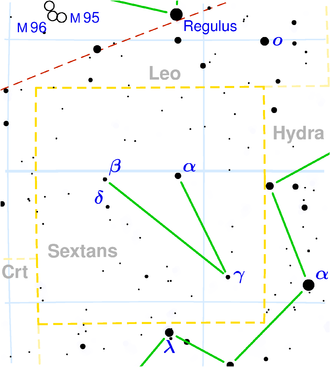NGC 3325
| Galaxy NGC 3325 |
|
|---|---|

|
|
| SDSS recording | |
| AladinLite | |
| Constellation | sextant |
|
Position equinox : J2000.0 , epoch : J2000.0 |
|
| Right ascension | 10 h 39 m 20.4 s |
| declination | -00 ° 12 ′ 01 ″ |
| Appearance | |
| Morphological type | E1 |
| Brightness (visual) | 12.4 mag |
| Brightness (B-band) | 13.4 mag |
| Angular expansion | 1.2 ′ × 1.1 ′ |
| Position angle | 55 ° |
| Surface brightness | 12.8 mag / arcmin² |
| Physical data | |
| Affiliation | LGG 205 |
| Redshift | 0.018873 +/- 0.000055 |
| Radial velocity | 5658 +/- 16 km / s |
|
Stroke distance v rad / H 0 |
(247 ± 17) · 10 6 ly (75.6 ± 5.3) Mpc |
| history | |
| discovery | Edouard Stephan |
| Discovery date | March 19, 1880 |
| Catalog names | |
| NGC 3325 • UGC 5795 • PGC 31689 • CGCG 009-093 • MCG + 00-27-036 • 2MASX J10392046-0012010 • | |
NGC 3325 is an elliptical galaxy from the Hubble type E1 in the constellation Sextant south of the celestial equator . It is an estimated 247 million light years away from the Milky Way and about 90,000 light years in diameter .
The galaxies NGC 3339 , NGC 3340 , IC 632 , IC 633 are located in the same area of the sky .
The object was discovered by Edouard Stephan on March 19, 1880 .
